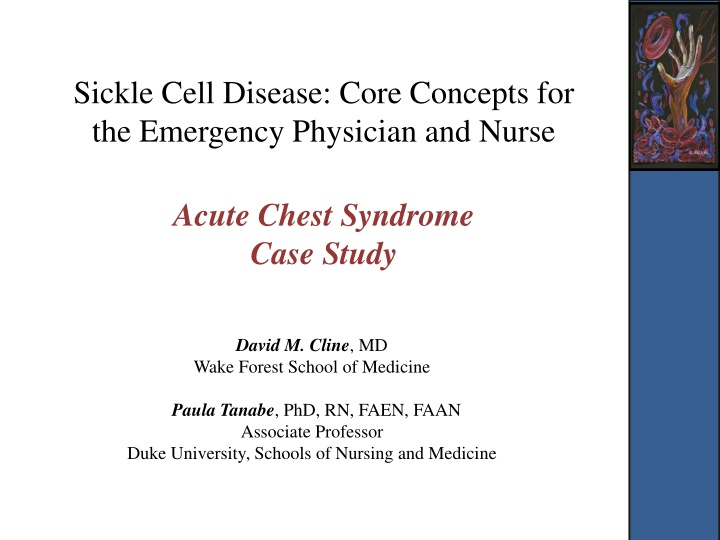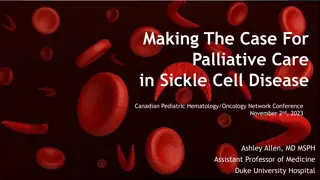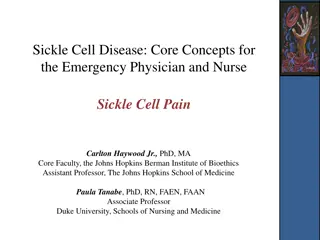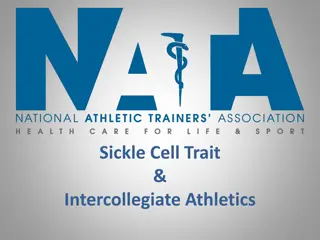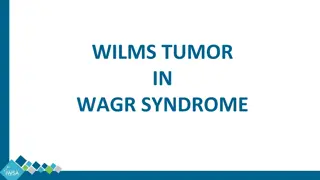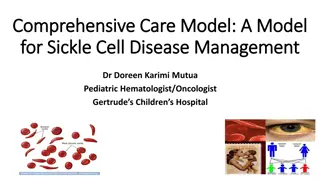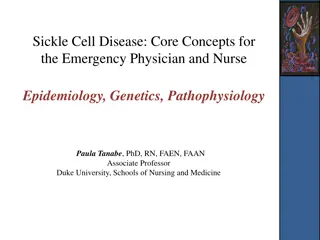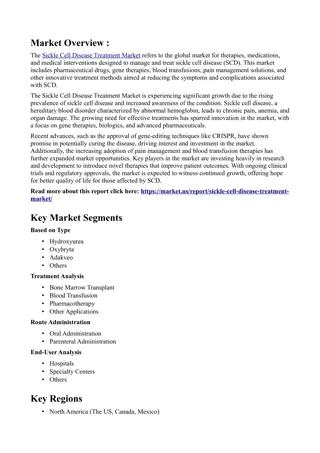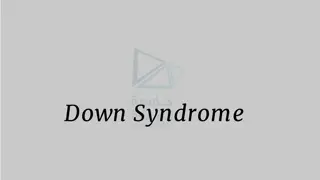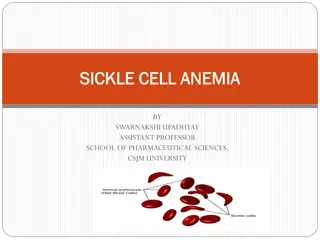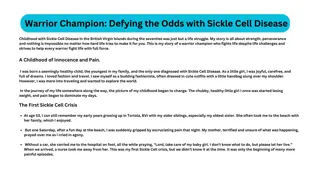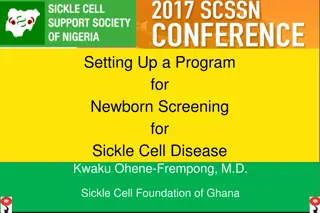Managing Acute Chest Syndrome in Sickle Cell Disease
A case study of a 31-year-old male with sickle cell disease presenting in the emergency department with a pain crisis. The patient has a history of avascular necrosis, priapism, NSTEMI, cholecystectomy, and previous acute chest syndrome. Explore the patient's symptoms, past medical history, and recommended management strategies for acute chest syndrome in sickle cell disease.
Download Presentation

Please find below an Image/Link to download the presentation.
The content on the website is provided AS IS for your information and personal use only. It may not be sold, licensed, or shared on other websites without obtaining consent from the author.If you encounter any issues during the download, it is possible that the publisher has removed the file from their server.
You are allowed to download the files provided on this website for personal or commercial use, subject to the condition that they are used lawfully. All files are the property of their respective owners.
The content on the website is provided AS IS for your information and personal use only. It may not be sold, licensed, or shared on other websites without obtaining consent from the author.
E N D
Presentation Transcript
Sickle Cell Disease: Core Concepts for the Emergency Physician and Nurse Acute Chest Syndrome Case Study David M. Cline, MD Wake Forest School of Medicine Paula Tanabe, PhD, RN, FAEN, FAAN Associate Professor Duke University, Schools of Nursing and Medicine
Objectives Identify recommended antibiotics for patients with sickle cell disease (SCD) diagnosed with acute chest syndrome (ACS) Identify indications for simple & exchange transfusion in patients with SCD admitted with ACS
Pretest- Question 1 What are the recommended antibiotics for patients with SCD diagnosed with ACS? a. Levofloxacin IV b. IV cephalosporin, and an oral macrolide antibiotic c. Vancomycin plus piperacillin/tazobactam IV d. Doxycyline IV
Pretest- Question 2 What are in the indications for simple transfusion in patients with SCD with ACS? a. Drop in hemoglobin of 1.0 g/dL below baseline b. Drop in hemoglobin of 2.0 g/dL below baseline c. Failure achieve a pulse oximetry reading of greater than 98%. d. Failure achieve a pulse oximetry reading of greater than 95%.
History of the Present Illness 31 year old black male with SS SCD presents the ED with complaint of pain crisis The patient states this episode is identical to his typical pain crisis, where he experiences pain in his chest, his abdomen, & both of his upper lateral thighs The pain began yesterday, & has not responded to his oral pain medication, Dilaudid 4 mg tabs, 1 every 4 hours as needed for pain
Past Medical History Additional past medical history includes avascular necrosis of both hips, priapism, NSTEMI, cholecystectomy, & one prior episode of acute chest syndrome He smokes cigarettes, pack per day, & drinks beer occasionally The patient averages 1 visit to the ED every month, & he is admitted to the hospital approximately 50% of the time
Physical Exam Triage vital signs include temperature of 99.6oF, blood pressure of 113/65 mm Hg, pulse 98 bpm, respirations 20/min, oxygen saturation of 93% on room air General: he appears acutely in pain HEENT is within normal limits except for mild icterus of the conjunctiva Lungs clear to auscultation & percussion Heart: heart rate & rhythm regular, no murmurs, no gallop, no rubs
Physical Exam-Continued Abdomen: soft with diffuse tenderness that is similar to what had been described previously in his medical record Extremities: He is tender over both hips & lateral thigh areas as previously described in the record. His peripheral pulses are intact Neuro: He is alert & oriented, CN 2-12 intact, sensation 5/5 & motor strength 5/5 through-out
Emergency Department Course The patient is placed on oxygen & IV fluids The patient is given several doses of pain medication to relieve his significant pain. Laboratory analysis reveals a white blood cell count of 17,000, with segs of 66.7%, Bands 1.76%, lymphs 25.8%, hemoglobin of 8.9 (at baseline for this patient). Chest X-ray is ordered; shows the following subtle finding (see next slide)
Chest X-ray Radiology: Basilar opacity over right base, best seen on the lateral film.
Hospital Course The patient is started on intravenous ceftriaxone, & azithromycin for atypical organisms 12 hours after admission, the oxygen saturation drops to 89%. In preparation for exchange transfusion, it is noted that the hemoglobin has dropped 1 gram from initial reading The patient is transferred to ICU, & exchange transfusion is started. He recovers uneventfully
Discussion The patient has 3 risk factors for acute chest syndrome: SS disease Currently smoker Prior history of acute chest syndrome Because the patient frequently complains of chest pain with his uncomplicated vaso-oclusive crisis, differentiating acute chest from uncomplicated pain crisis is difficult. Because the findings on chest x-ray are often subtle, especially initially, comparing the current film to prior films is essential
Discussion- Continued Additional red flags: temperature of 99.6 F, SPO2 of 93% on RA, white blood cell count of 17,000 The patient deteriorated after admission as recognized by his dropping oxygen saturations and hemoglobin. This is a common course with acute chest syndrome & therefore admitted patients with sickle cell disease should carefully monitored Guidelines suggest selection of IV cephalosporin, and an oral macrolide antibiotic to treat infection.
Discussion- Continued Guidelines suggest giving simple transfusion (10 mL/kg RBCs) to improve oxygen carrying capacity for patients with symptomatic ACS whose hemoglobin concentration falls 1.0 g/dL or more below baseline. If baseline Hgb is 9 g/dL or greater, simple blood transfusion may not be required Urgent exchange transfusion is recommended when there is rapid progression of ACS as manifested by oxygen saturation below 90% despite supplemental oxygen, increasing respiratory distress, progressive pulmonary infiltrates, and/or decline in hemoglobin concentration despite simple transfusion. In these cases, consult hematology and/or critical care, and/or apheresis specialists to provide therapy.
Case Scenario Cut and paste the link below into your browser to view this short video https://www.youtube.com/watch?v=urmg_fJ28 9c&feature=youtu.be
Posttest- Question 1 What are the recommended antibiotics for patients with SCD diagnosed with ACS? a. Levofloxacin IV b. IV cephalosporin, and an oral macrolide antibiotic c. Vancomycin plus piperacillin/tazobactam IV d. Doxycyline IV
Posttest- Question 2 What are in the indications for simple transfusion in patients with SCD with ACS? a. Drop in hemoglobin of 1.0 g/dL below baseline b. Drop in hemoglobin of 2.0 g/dL below baseline c. Failure achieve a pulse oximetry reading of greater than 98%. d. Failure achieve a pulse oximetry reading of greater than 95%.
Posttest Answers & Rationale Question 1 Answer : b) IV cephalosporin, and an oral macrolide antibiotic. Rationale: NHLBI expert panel recommendations suggest use of IV cephalosporin, and an oral macrolide antibiotic Question 2 Answer: a) Drop in hemoglobin of 1.0 g/dL below baseline Rationale: NHLBI expert panel recommendations suggest simple transfusion for patients with a drop in Hgb of 1.0 gm/dl below baseline. In addition patients with ACS and a drop in oxygen saturations below 90% should receive an exchange transfusion (see other indications in discussion above). Oxygen saturations above 90% should be maintained in the patient with ACS
References 1. National Heart, Lungs, And Blood Institute. (2014). Evidenced-based management of sickle cell disease. National Institute of Health. Retrieved fromhttp://www.nhlbi.nih.gov/sites/www.nhlbi.nih.gov/files/sickle-cell-disease-report.pdf
